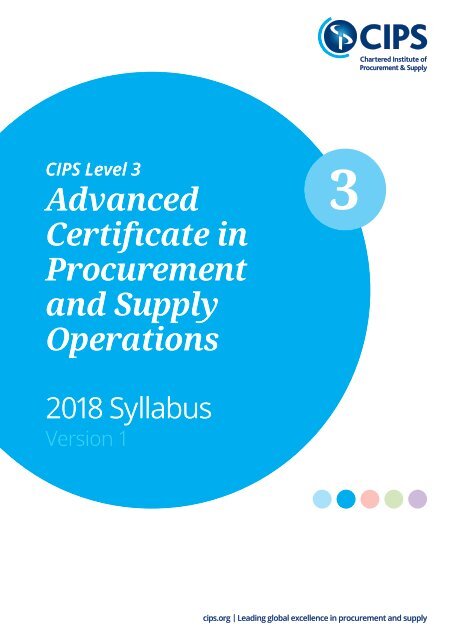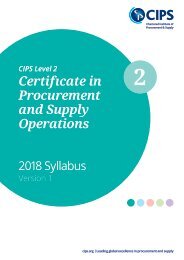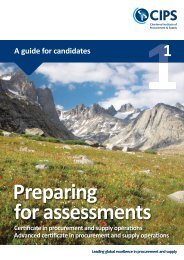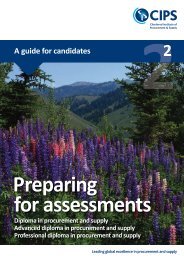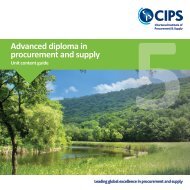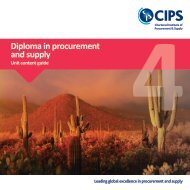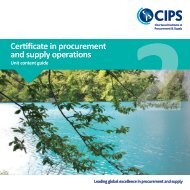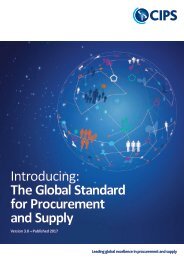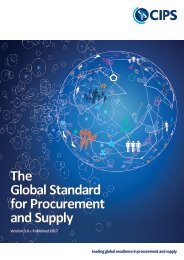CIPS Level 3 Certificate in Procurement and Supply Operations 2018 Syllabus
You also want an ePaper? Increase the reach of your titles
YUMPU automatically turns print PDFs into web optimized ePapers that Google loves.
<strong>CIPS</strong> <strong>Level</strong> 3<br />
Advanced<br />
Certifıcate <strong>in</strong><br />
<strong>Procurement</strong><br />
<strong>and</strong> <strong>Supply</strong><br />
<strong>Operations</strong><br />
3<br />
<strong>2018</strong> <strong>Syllabus</strong><br />
Version 1
Your<br />
qualifıcation<br />
The Chartered Institute of <strong>Procurement</strong> & <strong>Supply</strong> (<strong>CIPS</strong>) qualifications are recognised by education<br />
regulators from various countries. Our <strong>Level</strong> 3* Advanced <strong>Certificate</strong> <strong>in</strong> <strong>Procurement</strong> <strong>and</strong><br />
<strong>Operations</strong> is a vocationally related professional qualification. <strong>CIPS</strong> is an Ofqual (Engl<strong>and</strong>), CCEA<br />
Regulation (Northern Irel<strong>and</strong>) <strong>and</strong> Qualifications Wales, regulated qualifications award<strong>in</strong>g<br />
organisation. The <strong>CIPS</strong> qualifications are listed on the Regulated Qualifications Framework (RQF).<br />
<strong>CIPS</strong> members will be able to have the confidence <strong>in</strong> our regulated qualifications, which reliably<br />
<strong>in</strong>dicate the knowledge, skills <strong>and</strong> underst<strong>and</strong><strong>in</strong>g that a learner is required to demonstrate.<br />
This is an entry level vocationally related qualification it Developed <strong>in</strong> close collaboration with experts from the<br />
is designed to follow on from the <strong>CIPS</strong> <strong>Level</strong> 2 <strong>Certificate</strong> procurement <strong>and</strong> supply profession <strong>and</strong> bus<strong>in</strong>esses, <strong>and</strong><br />
<strong>in</strong> <strong>Procurement</strong> <strong>and</strong> <strong>Supply</strong> <strong>Operations</strong> as learners are with the providers who will be deliver<strong>in</strong>g the qualifications,<br />
expected to develop, use <strong>and</strong> apply the professional <strong>CIPS</strong> <strong>Level</strong> 3 Advanced <strong>Certificate</strong> <strong>in</strong> <strong>Procurement</strong> <strong>and</strong> <strong>Supply</strong><br />
language <strong>and</strong> skill sets <strong>in</strong>troduced at <strong>Level</strong> 2 with<strong>in</strong> a <strong>Operations</strong> is designed for <strong>in</strong>dividuals who will be work<strong>in</strong>g<br />
practical work<strong>in</strong>g environment. This qualification will at the Tactical but mov<strong>in</strong>g towards the Operational level of<br />
prepare <strong>in</strong>termediate level learners look<strong>in</strong>g to specialise the <strong>CIPS</strong> Global St<strong>and</strong>ard for <strong>Procurement</strong> <strong>and</strong> <strong>Supply</strong>. This<br />
<strong>in</strong> procurement <strong>and</strong> supply <strong>and</strong> to progress onto the <strong>CIPS</strong> is the first level of the <strong>CIPS</strong> qualifications structure where<br />
<strong>Level</strong> 4 Diploma <strong>in</strong> <strong>Procurement</strong> <strong>and</strong> <strong>Supply</strong>.<br />
elective modules are <strong>in</strong>troduced, giv<strong>in</strong>g learners the choice of<br />
a specific professional path such as <strong>Procurement</strong> or <strong>Supply</strong><br />
Entry level Entry level Highest Cha<strong>in</strong>. Entry level<br />
<strong>Level</strong> 2<br />
<strong>Certificate</strong> <strong>in</strong><br />
<strong>Procurement</strong><br />
<strong>and</strong> <strong>Supply</strong><br />
<strong>Operations</strong><br />
<strong>Level</strong> 3<br />
Advanced<br />
<strong>Certificate</strong> <strong>in</strong><br />
<strong>Procurement</strong><br />
<strong>and</strong> <strong>Supply</strong><br />
<strong>Operations</strong><br />
<strong>Level</strong> 4<br />
Diploma <strong>in</strong><br />
<strong>Procurement</strong><br />
<strong>and</strong><br />
<strong>Supply</strong><br />
<strong>Level</strong> 5<br />
Advanced<br />
Diploma <strong>in</strong><br />
<strong>Procurement</strong><br />
<strong>and</strong> <strong>Supply</strong><br />
<strong>Level</strong> 6<br />
Professional<br />
Diploma <strong>in</strong><br />
<strong>Procurement</strong><br />
<strong>and</strong> <strong>Supply</strong><br />
Next steps<br />
This qualification provides progression to the <strong>CIPS</strong> <strong>Level</strong> 4 Diploma <strong>in</strong><br />
<strong>Procurement</strong> <strong>and</strong> <strong>Supply</strong>.<br />
<strong>Level</strong> 4<br />
* Refers to levels with<strong>in</strong> the RQF. Other regulatory bodies may have different correspond<strong>in</strong>g levels<br />
We have created a suite of regulated, flexible <strong>and</strong> agile professional<br />
qualifications that pave the way for a whole new generation of global<br />
procurement <strong>and</strong> supply learners.<br />
Dr Gary Ramsden, F<strong>CIPS</strong> Chartered Professional, Head of Education Development <strong>and</strong> St<strong>and</strong>ards, <strong>CIPS</strong><br />
Based on the Tactical <strong>and</strong> Operational competency levels of <strong>CIPS</strong> Global St<strong>and</strong>ard<br />
cips.org/qualifications
Guide to qualification content<br />
Four CORE MANDATORY modules make up 24 of the required credits<br />
30<br />
Credits<br />
required for<br />
completion<br />
CORE <strong>Level</strong> 3 <strong>Procurement</strong><br />
<strong>and</strong> <strong>Supply</strong> Environments<br />
(L3M1)<br />
6<br />
CREDITS<br />
CORE <strong>Level</strong> 3 Contract<br />
Adm<strong>in</strong>istration (L3M3) 6<br />
CREDITS<br />
CORE <strong>Level</strong> 3 Ethical<br />
<strong>Procurement</strong> <strong>and</strong> <strong>Supply</strong><br />
(L3M2)<br />
6<br />
CREDITS<br />
CORE <strong>Level</strong> 3 Team<br />
Dynamics <strong>and</strong> Change (L3M4) 6<br />
CREDITS<br />
24<br />
Credits made<br />
up of CORE<br />
MANDATORY<br />
modules<br />
Choose one ELECTIVE module to make up the f<strong>in</strong>al six required credits<br />
ELECTIVE <strong>Level</strong> 3 Socially<br />
Responsible <strong>Procurement</strong><br />
(L3M5)<br />
6<br />
CREDITS<br />
ELECTIVE <strong>Level</strong> 3 Socially<br />
Responsible Warehous<strong>in</strong>g<br />
<strong>and</strong> Distribution (L3M6)<br />
6<br />
CREDITS<br />
6<br />
Credits made up<br />
of your choice of<br />
ELECTIVE<br />
module<br />
Who is it for?<br />
This qualification will prepare <strong>in</strong>termediate level learners look<strong>in</strong>g to specialise <strong>in</strong> procurement <strong>and</strong> supply <strong>and</strong><br />
to progress onto the <strong>CIPS</strong> <strong>Level</strong> 4 Diploma <strong>in</strong> <strong>Procurement</strong> <strong>and</strong> <strong>Supply</strong>.<br />
What will I learn?<br />
Learn how to apply factual, procedural <strong>and</strong> theoretical knowledge of procurement <strong>and</strong> supply. You will be able<br />
to completes tasks <strong>and</strong> address problems that are well-def<strong>in</strong>ed but may be complex <strong>and</strong> non-rout<strong>in</strong>e. You will<br />
underst<strong>and</strong> what relevant <strong>in</strong>formation is required <strong>and</strong> how to <strong>in</strong>terpret <strong>and</strong> review its effectiveness.<br />
Entry requirements<br />
This is the second entry level qualification, there are no formal entry requirements.<br />
Total credits required for completion<br />
30<br />
03
How<br />
long will<br />
I study for?<br />
Your total qualification time (TQT)<br />
The TQT <strong>in</strong>dicates the overall number of guided learn<strong>in</strong>g hours, additional<br />
self-study <strong>and</strong> assessment time that is required.<br />
300<br />
TQT HRS<br />
Guided learn<strong>in</strong>g hours (GLH)<br />
It is expected that you will undertake 200 GLH. The def<strong>in</strong>ition of guided<br />
learn<strong>in</strong>g hours is: ‘A measure of the amount of <strong>in</strong>put time required to<br />
achieve the qualification. This <strong>in</strong>cludes lectures, tutorials <strong>and</strong> practicals,<br />
as well as supervised study <strong>in</strong>, for example, learn<strong>in</strong>g centres <strong>and</strong><br />
workshops’.<br />
Self-study requirement (SSR)<br />
Additionally, we recommend that you also commit to at least [90 SSR]<br />
hours. This <strong>in</strong>cludes wider read<strong>in</strong>g of the subject areas <strong>and</strong> revision to give<br />
yourself the best preparation for successfully achiev<strong>in</strong>g the qualification.<br />
Total exam time<br />
All the modules <strong>in</strong> <strong>CIPS</strong> qualifications are assessed by an exam<strong>in</strong>ation.<br />
200<br />
GLH HRS<br />
90<br />
SSR HRS<br />
10<br />
HRS<br />
cips.org/qualifications
C<br />
CORE MODULE<br />
<strong>CIPS</strong> GLOBAL<br />
STANDARD<br />
2.1 • 2.2 • 4.4 • 11.2<br />
<strong>Procurement</strong><br />
<strong>and</strong> <strong>Supply</strong><br />
Environments<br />
[L3M1]<br />
Module purpose<br />
2HRS<br />
EXAM DURATION<br />
HOURS<br />
60<br />
HRS<br />
TOTAL QUALIFICATION<br />
TIME (TQT)<br />
On completion of this module, learners will be able to identify the range of environments<br />
<strong>in</strong> which procurement <strong>and</strong> supply is expected to operate <strong>and</strong> the external factors that can<br />
impact on overall success.<br />
Module aim(s)<br />
<strong>Procurement</strong> <strong>and</strong> supply is to operate <strong>in</strong> a varied range of environments. As well as the<br />
public <strong>and</strong> private sectors, those responsible for the procurement <strong>and</strong> supply function may<br />
f<strong>in</strong>d themselves work<strong>in</strong>g with those <strong>in</strong> not-for-profit organisations. This module is designed<br />
for those who are <strong>in</strong>volved <strong>in</strong> the procurement <strong>and</strong> supply function, who must recognise the<br />
wider environment <strong>in</strong> which they work <strong>and</strong> the impacts that different types of organisations<br />
can have on successfully meet<strong>in</strong>g with overall organisational needs. They must know the<br />
importance of the external environment <strong>and</strong> also identify the procedures that regulate<br />
procurement <strong>and</strong> supply.<br />
6<br />
Credit value<br />
05
Learn<strong>in</strong>g outcomes, assessment criteria <strong>and</strong> <strong>in</strong>dicative content<br />
1.0 Know the different sectors of procurement <strong>and</strong> supply<br />
1.1 Def<strong>in</strong>e the different types <strong>and</strong> functions of the private<br />
sector<br />
• Def<strong>in</strong>itions <strong>and</strong> different types of private sector<br />
organisations – sole traders, partnerships, registered<br />
companies, <strong>in</strong>corporated <strong>and</strong> un<strong>in</strong>corporated<br />
companies, SME, mult<strong>in</strong>ational corporations<br />
• The size <strong>and</strong> scope of the private sector <strong>in</strong> different<br />
economies<br />
• Functions of private sector organisations such<br />
as profit, growth, market share, share price,<br />
other f<strong>in</strong>ancial measures, corporate <strong>and</strong> social<br />
responsibility<br />
1.2 Describe the role <strong>and</strong> scope of procurement <strong>and</strong><br />
supply <strong>in</strong> the private sector<br />
• Sole trade, partnerships, registered companies,<br />
<strong>in</strong>corporated <strong>and</strong> un<strong>in</strong>corporated companies<br />
• Small <strong>and</strong> medium sized organisations (SMEs)<br />
• Mult<strong>in</strong>ational organisations<br />
• The roles of procurement <strong>and</strong> supply <strong>in</strong> the private<br />
sector<br />
1.3 Describe the role <strong>and</strong> scope of procurement <strong>and</strong><br />
supply <strong>in</strong> the public sector<br />
• Def<strong>in</strong><strong>in</strong>g the public sector<br />
• Central <strong>and</strong> local government<br />
• The functions of public sector organisations<br />
• The roles of procurement <strong>and</strong> supply <strong>in</strong> the public<br />
sector<br />
• Commission<strong>in</strong>g <strong>and</strong> procurement<br />
• Achiev<strong>in</strong>g budget sav<strong>in</strong>gs <strong>and</strong> other sources of added<br />
value<br />
• Provid<strong>in</strong>g access to services<br />
• Regulat<strong>in</strong>g organisations <strong>and</strong> <strong>in</strong>dividuals<br />
1.4 Describe the role <strong>and</strong> scope of procurement <strong>and</strong><br />
supply <strong>in</strong> the not-for-profit <strong>and</strong> third sector<br />
• Def<strong>in</strong><strong>in</strong>g the not-for-profit <strong>and</strong> third sector<br />
• Public accountability for the not-for-profit <strong>and</strong> third<br />
sector<br />
• Def<strong>in</strong>e the role of procurement <strong>and</strong> supply <strong>in</strong> the<br />
not-for-profit <strong>and</strong> third sector<br />
2.0 Underst<strong>and</strong> types of pric<strong>in</strong>g arrangements <strong>in</strong><br />
commercial agreements<br />
2.1 Expla<strong>in</strong> how pric<strong>in</strong>g arrangements are used <strong>in</strong><br />
commercial agreements to ensure effective price <strong>and</strong><br />
cost management<br />
• Pric<strong>in</strong>g schedules<br />
• Fixed pric<strong>in</strong>g arrangements<br />
• Cost plus <strong>and</strong> cost reimbursable pric<strong>in</strong>g<br />
arrangements<br />
• Indexation <strong>and</strong> price adjustment formulae<br />
• Incentivised ga<strong>in</strong> share pric<strong>in</strong>g<br />
• Payment terms<br />
• The use of open book cost<strong>in</strong>g <strong>and</strong> adjustments<br />
3.0 Know the external environment <strong>and</strong> its impact on<br />
procurement <strong>and</strong> supply<br />
3.1 Identify the impact of the external environment on<br />
procurement <strong>and</strong> supply<br />
• The use of environmental scann<strong>in</strong>g<br />
• The use of PEST (political, economic, social<br />
<strong>and</strong> technological) criteria or STEEPLED (social,<br />
technological, economic, environmental, political,<br />
legislation, ethical <strong>and</strong> demographic) criteria that<br />
impacts on organisations’ external environment<br />
• The five forces model<br />
• Competitive market forces<br />
• Dem<strong>and</strong> <strong>and</strong> supply<br />
• Market factors<br />
• Product life cycles<br />
cips.org/qualifications
3.2 Describe how the implications of economic criteria<br />
impact on procurement <strong>and</strong> supply<br />
• Macro-economic criteria such as <strong>in</strong>terest rates,<br />
<strong>in</strong>flation, exchange rates, level of economic activity<br />
(GDP/ GNP) that impacts on organisations<br />
• Micro-economic criteria such as dem<strong>and</strong> <strong>and</strong> supply<br />
that impacts on organisations<br />
3.3 Describe how the implications of political <strong>and</strong><br />
legislative criteria that impact on procurement <strong>and</strong><br />
supply<br />
• Political criteria such as stability <strong>and</strong> <strong>in</strong>stability that<br />
impacts on organisations, different economic sectors<br />
<strong>and</strong> on countries<br />
• Legislation that impacts on organisations such as<br />
on st<strong>and</strong>ards, health <strong>and</strong> safety, environmental<br />
st<strong>and</strong>ards <strong>and</strong> employment law<br />
3.4 Describe how the implications of environmental <strong>and</strong><br />
ethical criteria impact on procurement <strong>and</strong> supply<br />
• Environmental criteria such as natural risks, waste<br />
emissions, pollution <strong>and</strong> energy efficiency that<br />
impact on organisations<br />
• Ethical <strong>and</strong> social criteria such as ethical codes,<br />
employment rights, community benefits,<br />
work<strong>in</strong>g conditions <strong>and</strong> st<strong>and</strong>ards that impact on<br />
organisations<br />
3.5 Describe how the implications of social criteria impact<br />
on procurement <strong>and</strong> supply<br />
• Chang<strong>in</strong>g societal preferences, tastes <strong>and</strong> fashions,<br />
demographics, labour <strong>and</strong> fair-trade st<strong>and</strong>ards <strong>and</strong><br />
how these can impact on organisations<br />
• Corporate social responsibility<br />
4.0 Underst<strong>and</strong> procedures that regulate procurement<br />
<strong>and</strong> supply<br />
4.1 Describe the types of documentation used <strong>in</strong><br />
procurement <strong>and</strong> supply<br />
• Requisitions<br />
• Orders<br />
• Delivery notes<br />
• Invoices<br />
• Other documents typically used <strong>in</strong> procurement <strong>and</strong><br />
supply<br />
4.2 Expla<strong>in</strong> how documented policies <strong>and</strong> procedures are<br />
used with<strong>in</strong> procurement <strong>and</strong> supply<br />
• The responsibilities for procurement<br />
• Regulations relat<strong>in</strong>g to competition<br />
• <strong>Level</strong>s of delegated authority<br />
• Responsibilities for the stages of the sourc<strong>in</strong>g<br />
process<br />
• Responsibilities for ensur<strong>in</strong>g <strong>in</strong>voice clearance <strong>and</strong><br />
payment<br />
• Responsibilities for ensur<strong>in</strong>g that requisitions,<br />
orders <strong>and</strong> <strong>in</strong>voices are clear <strong>and</strong> correct <strong>and</strong> clarify<br />
requirements for stakeholders<br />
• Corporate governance<br />
07
Ethical<br />
<strong>Procurement</strong><br />
<strong>and</strong> <strong>Supply</strong><br />
[L3M2]<br />
C<br />
CORE MODULE<br />
<strong>CIPS</strong> GLOBAL<br />
STANDARD<br />
4.4 • 7.1 • 8.2 • 11.2<br />
Module purpose<br />
On completion of this module, learners will be able to identify the significance of ethics<br />
for procurement <strong>and</strong> supply <strong>and</strong> def<strong>in</strong>e each stage of the sourc<strong>in</strong>g process, expla<strong>in</strong><strong>in</strong>g<br />
how operational performance can be measured <strong>and</strong> improved <strong>in</strong> support of added value<br />
operations.<br />
Module aim(s)<br />
The significant impact on reputation <strong>and</strong> customer perception mean that ethics <strong>and</strong><br />
responsible procurement should be at the heart of all organisational procurement <strong>and</strong><br />
supply activity. A successful organisation will strive to add value at every stage of its<br />
operations <strong>and</strong> will seek ways to measure <strong>and</strong> improve performance. This module is<br />
designed for those responsible for the application of ethical codes of conduct on the<br />
procurement <strong>and</strong> supply operation <strong>and</strong> who are expected to know how to address potential<br />
conflicts of <strong>in</strong>terest. They must also def<strong>in</strong>e tasks associated with each stage of the sourc<strong>in</strong>g<br />
process <strong>and</strong> identify the techniques available to achieve added value, recognis<strong>in</strong>g how<br />
operational performance can be measured <strong>and</strong> improved.<br />
Credit value<br />
2HRS<br />
EXAM DURATION<br />
HOURS<br />
60<br />
HRS<br />
TOTAL QUALIFICATION<br />
TIME (TQT)<br />
6<br />
cips.org/qualifications
Learn<strong>in</strong>g outcomes, assessment criteria <strong>and</strong> <strong>in</strong>dicative content<br />
1.0 Know techniques that can achieve added value <strong>and</strong> its<br />
contribution to organisational success<br />
1.1 Expla<strong>in</strong> how to use techniques to obta<strong>in</strong> supplies to<br />
the purchaser’s requirements<br />
• Def<strong>in</strong><strong>in</strong>g sources of added value<br />
• Def<strong>in</strong><strong>in</strong>g value for money<br />
• Apply<strong>in</strong>g the five rights to procurements of both<br />
products <strong>and</strong> services<br />
• Discuss the concept of life time costs<br />
1.2 Identify the contribution that value for money has to<br />
make to organisational success<br />
• Efficiency<br />
• Effectiveness<br />
• Economies of scale vs. quality of product/service<br />
• Value eng<strong>in</strong>eer<strong>in</strong>g<br />
• Value analysis<br />
1.3 Expla<strong>in</strong> how to use techniques that are available to<br />
achieve quality supplies<br />
• Def<strong>in</strong><strong>in</strong>g quality<br />
• Quality st<strong>and</strong>ards, processes <strong>and</strong> procedures<br />
• The use of quality assurance<br />
• The concept of zero defects<br />
• Assess<strong>in</strong>g quality of supplies of products <strong>and</strong> services<br />
1.4 Identify techniques to secure required quantities<br />
with<strong>in</strong> required timescales<br />
• Internal, external <strong>and</strong> total lead time<br />
• Expedit<strong>in</strong>g <strong>and</strong> measur<strong>in</strong>g delivery performance<br />
1.5 Identify value for money criteria<br />
• Pric<strong>in</strong>g/costs<br />
• Delivered quality<br />
• Timescales, quantities <strong>and</strong> location requirements<br />
• Measur<strong>in</strong>g the achievement of quality <strong>and</strong> timescales<br />
• Evaluate data to measure <strong>and</strong> improve the<br />
performance of external suppliers<br />
2.0 Know tasks associated with each stage of the sourc<strong>in</strong>g<br />
process<br />
2.1 Describe how procurement needs are established<br />
• Liaison with users <strong>and</strong> customers <strong>and</strong> underst<strong>and</strong><strong>in</strong>g<br />
their commercial needs<br />
• Review<strong>in</strong>g needs from customers<br />
• The make or buy decision<br />
• Def<strong>in</strong>itions of specifications<br />
2.2 Identify criteria that should be applied <strong>in</strong> creat<strong>in</strong>g<br />
specifications<br />
• The importance of specifications <strong>in</strong> contracts with<br />
external customers <strong>and</strong> suppliers<br />
• Creat<strong>in</strong>g specifications for products <strong>and</strong> services<br />
• Conformance <strong>and</strong> output or outcome based<br />
approaches to develop<strong>in</strong>g specifications<br />
• The role of Key Performance Indicators (KPIs)<br />
2.3 Describe approaches to the sourc<strong>in</strong>g of supplies<br />
• Survey<strong>in</strong>g the market<br />
• Supplier appraisal<br />
• Invit<strong>in</strong>g quotations <strong>and</strong> tenders<br />
• Assess<strong>in</strong>g quotations <strong>and</strong> tenders<br />
• The use of e-sourc<strong>in</strong>g technologies<br />
• Measur<strong>in</strong>g supplier performance<br />
2.4 Describe approaches to the formation of agreements<br />
with external organisations<br />
• Deal<strong>in</strong>g with queries <strong>and</strong> clarifications<br />
• Ensur<strong>in</strong>g transparency <strong>and</strong> fairness with suppliers<br />
• Mistakes <strong>and</strong> second bids <strong>in</strong> tenders<br />
• The use of reverse auctions/e-auctions<br />
• Form<strong>in</strong>g agreements with customers <strong>and</strong> suppliers<br />
• Transition <strong>and</strong> mobilisation arrangements<br />
09
3.0 Underst<strong>and</strong> the significance of ethics for procurement<br />
<strong>and</strong> supply<br />
3.1 Expla<strong>in</strong> the importance of the <strong>CIPS</strong> Code of Conduct <strong>in</strong><br />
procurement <strong>and</strong> supply<br />
• Enhanc<strong>in</strong>g <strong>and</strong> protect<strong>in</strong>g the st<strong>and</strong><strong>in</strong>g of the<br />
profession<br />
• Ma<strong>in</strong>ta<strong>in</strong><strong>in</strong>g the highest st<strong>and</strong>ard of <strong>in</strong>tegrity <strong>in</strong> all<br />
bus<strong>in</strong>ess relationships<br />
• Promot<strong>in</strong>g the eradication of unethical bus<strong>in</strong>ess<br />
relationships<br />
• Enhanc<strong>in</strong>g the proficiency <strong>and</strong> stature of the<br />
profession<br />
• Ensur<strong>in</strong>g compliance with laws <strong>and</strong> regulations<br />
3.2 Describe the use of codes of ethics <strong>in</strong> procurement<br />
<strong>and</strong> supply<br />
• The importance <strong>and</strong> role of codes of ethics<br />
• Monitor the work of stakeholders to ensure that<br />
codes of ethics are upheld<br />
• How to deal with <strong>and</strong> escalate to senior management<br />
any suspected breaches of codes of ethics<br />
3.3 Expla<strong>in</strong> the conflicts of <strong>in</strong>terest that can exist <strong>in</strong> the<br />
work of procurement <strong>and</strong> supply <strong>and</strong> how to deal with<br />
them<br />
• Identify<strong>in</strong>g potential conflicts of <strong>in</strong>terest<br />
• How to address potential conflicts of <strong>in</strong>terest<br />
• How to ensure that ethical practices are ma<strong>in</strong>ta<strong>in</strong>ed<br />
<strong>and</strong> prioritised<br />
4.0 Underst<strong>and</strong> how operational performance of the<br />
procurement <strong>and</strong> supply function can be measured<br />
<strong>and</strong> improved<br />
4.1 Recognise the importance of deliver<strong>in</strong>g customer<br />
service <strong>and</strong> how to improve<br />
• Methods to evaluate customer service <strong>and</strong><br />
stakeholder satisfaction<br />
• How to develop action plans to improve performance<br />
4.2 Expla<strong>in</strong> ways to measure cycle times for the sourc<strong>in</strong>g<br />
process<br />
• Methods to evaluate the timescales for sourc<strong>in</strong>g<br />
processes<br />
• How to identify the causes of delays <strong>and</strong> take<br />
appropriate actions to reduce timescales when<br />
required<br />
4.3 Expla<strong>in</strong> methods to assess the performance of <strong>and</strong><br />
control budgets<br />
• Methods to analyse departmental budgets <strong>and</strong><br />
evaluate the reasons for variances between<br />
forecasted <strong>and</strong> actual expenditures<br />
• Def<strong>in</strong>e methods <strong>and</strong> actions to mitigate future<br />
variances<br />
cips.org/qualifications
C<br />
CORE MODULE<br />
Contract<br />
Adm<strong>in</strong>istration<br />
[L3M3]<br />
<strong>CIPS</strong> GLOBAL<br />
STANDARD<br />
6.2 • 7.3 • 8.3<br />
Module purpose<br />
2HRS<br />
EXAM DURATION<br />
HOURS<br />
60<br />
HRS<br />
TOTAL QUALIFICATION<br />
TIME (TQT)<br />
On completion of this module, learners will be able to expla<strong>in</strong> adm<strong>in</strong>istrative processes<br />
beh<strong>in</strong>d contract development <strong>and</strong> how to measure contract performance. They will identify<br />
how to achieve competitive pric<strong>in</strong>g <strong>and</strong> be able to describe how effective tender<strong>in</strong>g is<br />
achieved.<br />
Module aim(s)<br />
In any organisation, a significant element of the procurement <strong>and</strong> supply function is<br />
based around the contract<strong>in</strong>g process. This module is designed for those <strong>in</strong>volved <strong>in</strong> the<br />
development <strong>and</strong> subsequent adm<strong>in</strong>istration <strong>and</strong> performance monitor<strong>in</strong>g of contracts. To<br />
ensure success, such <strong>in</strong>dividuals must demonstrate knowledge <strong>and</strong> comprehension of how<br />
to achieve competitive pric<strong>in</strong>g <strong>and</strong> also how effective tender<strong>in</strong>g is achieved.<br />
6<br />
Credit value<br />
11
Learn<strong>in</strong>g outcomes, assessment criteria <strong>and</strong> <strong>in</strong>dicative content<br />
1.0 Know the adm<strong>in</strong>istrative content <strong>and</strong> key tasks<br />
associated with commercial contracts<br />
1.1 Identify types of contracts <strong>and</strong> agreements<br />
• Spot purchases<br />
• Term contracts<br />
• Framework agreements (or blanket orders/panel<br />
agreements)<br />
• Call offs<br />
1.2 Describe the purpose of the documents that compose<br />
a contract for the purchas<strong>in</strong>g or supply of goods <strong>and</strong>/<br />
or services<br />
• The specification<br />
• The key performance <strong>in</strong>dicators (KPIs)<br />
• The contract terms<br />
• The pric<strong>in</strong>g schedule<br />
• Other schedules (such as health <strong>and</strong> safety, use of<br />
subcontractors)<br />
• Non-disclosure/confidentiality agreements<br />
1.3 Describe the stages <strong>in</strong>volved <strong>in</strong> form<strong>in</strong>g contracts for<br />
the purchas<strong>in</strong>g or supply of goods <strong>and</strong>/or services<br />
• Requests for quotations/<strong>in</strong>formation/tender<br />
enquiries<br />
• Quotations/tenders received<br />
• Orders/acceptance of tenders<br />
• Delivery notes/acknowledgements<br />
• Invoic<strong>in</strong>g <strong>and</strong> payment<br />
• The use of contract registers<br />
1.4 Describe how to develop <strong>and</strong> present bus<strong>in</strong>ess cases<br />
to justify expenditure on supplies, services or projects<br />
• Costs<br />
• Benefits<br />
• Options<br />
• Alignment with organisational needs<br />
• Timescales<br />
2.0 Underst<strong>and</strong> how to achieve competitive pric<strong>in</strong>g <strong>and</strong><br />
the role of negotiation <strong>in</strong> procurement <strong>and</strong> supply<br />
2.1 Expla<strong>in</strong> the use <strong>and</strong> comparison of competition to<br />
obta<strong>in</strong> quotations on price<br />
• The use of competitive pric<strong>in</strong>g with suppliers through<br />
monitor<strong>in</strong>g prices <strong>and</strong> obta<strong>in</strong><strong>in</strong>g quotations<br />
• Compar<strong>in</strong>g historical prices with newly quoted<br />
prices <strong>and</strong> evaluat<strong>in</strong>g the reasons for any significant<br />
discrepancies<br />
• Tak<strong>in</strong>g appropriate actions to secure competitive<br />
pric<strong>in</strong>g<br />
2.2 Recognise the role of commercial negotiations <strong>in</strong> the<br />
work of procurement <strong>and</strong> supply<br />
• Def<strong>in</strong>itions of commercial negotiation<br />
• Collaborative w<strong>in</strong>-w<strong>in</strong> <strong>in</strong>tegrative approaches to<br />
negotiation<br />
• Distributive w<strong>in</strong>-lose distributive approaches to<br />
negotiation<br />
• Negotiation <strong>in</strong> relation to the stages of the sourc<strong>in</strong>g<br />
process<br />
• Sources of conflict that can arise <strong>in</strong> the work of<br />
procurement <strong>and</strong> supply<br />
• The <strong>in</strong>fluence of stakeholders <strong>in</strong> negotiation<br />
2.3 Expla<strong>in</strong> approaches to negotiate competitive prices<br />
• The l<strong>in</strong>k between costs, price, marg<strong>in</strong>s <strong>and</strong> mark-ups<br />
• Use available data on submitted prices<br />
• Reta<strong>in</strong> or improve other aspects of value for money<br />
such as quality, availability <strong>and</strong> susta<strong>in</strong>ability with<strong>in</strong><br />
the negotiation process<br />
• Analyse actual outcomes from the negotiation<br />
process with planned outcomes <strong>and</strong> evaluate the<br />
reasons beh<strong>in</strong>d any differences<br />
cips.org/qualifications
3.0 Know how effective tender<strong>in</strong>g is achieved<br />
3.1 Identify the <strong>in</strong>itial actions processes associated with<br />
the tender<strong>in</strong>g process<br />
• <strong>Supply</strong>/market research<br />
• Early supplier engagement<br />
• Pre-contract dialogue<br />
• Develop <strong>and</strong> improve commercial <strong>and</strong> technical<br />
solutions<br />
3.2 Describe <strong>in</strong>itial tender process documentation <strong>and</strong><br />
associated content<br />
• Invitations to tender<br />
• KPIs<br />
• Contract terms<br />
• Pric<strong>in</strong>g schedule <strong>and</strong> other special to type schedules<br />
• Prequalification questionnaires<br />
3.3 Identify the tender evaluation <strong>and</strong> acceptance process<br />
• Check tender details <strong>and</strong> take any necessary<br />
remedial actions<br />
• Assess tender proposals aga<strong>in</strong>st <strong>in</strong>itial requirements<br />
• Awareness of specification creep<br />
3.4 Outl<strong>in</strong>e the regulations that can impact on the<br />
tender<strong>in</strong>g process<br />
• International frameworks<br />
• Non-discrim<strong>in</strong>ation<br />
• Free movement of goods<br />
• Freedom to provide services<br />
• Freedom of establishment<br />
• Equality of treatment<br />
• Transparency<br />
• Mutual recognition<br />
• Code of ethics<br />
• Codes of conduct<br />
4.0 Underst<strong>and</strong> how to measure contract performance<br />
4.1 Describe the use of data as a contract performance<br />
measure<br />
• Types of data<br />
• Data gather<strong>in</strong>g <strong>and</strong> analysis methods<br />
• Actions to address under performance<br />
• Penalty clauses<br />
4.2 Expla<strong>in</strong> the use of Key Performance Indicators (KPI)<br />
• Quality performance<br />
• Cost management<br />
• Resources <strong>and</strong> delivery<br />
• The use of audits to verify performance <strong>and</strong> costs<br />
• The use of SMART targets for supplier performance<br />
<strong>and</strong> agree their application with suppliers <strong>and</strong> other<br />
stakeholders<br />
• Agree mitigat<strong>in</strong>g actions with suppliers <strong>and</strong> other<br />
stakeholders<br />
4.3 Expla<strong>in</strong> types of contractual risk <strong>and</strong> how to manage<br />
them<br />
• Use of risk registers<br />
• Internal organisational risk<br />
• Market economic risk<br />
• Performance based risk<br />
13
Team Dynamics<br />
<strong>and</strong> Change<br />
[L3M4]<br />
C<br />
CORE MODULE<br />
<strong>CIPS</strong> GLOBAL<br />
STANDARD<br />
9.1 • 9.2<br />
Module purpose<br />
On completion of this module, learners will be able to identify the <strong>in</strong>fluence that people<br />
<strong>and</strong> teams can have on procurement <strong>and</strong> supply success <strong>and</strong> recognise the challenges<br />
associated with <strong>and</strong> methods to achieve, organisational change.<br />
Module aim(s)<br />
Individuals with responsibility for procurement <strong>and</strong> supply activity are to operate <strong>in</strong> a<br />
range of environments <strong>and</strong> with<strong>in</strong> a correspond<strong>in</strong>gly broad variety of teams. The <strong>in</strong>fluence<br />
of the <strong>in</strong>dividual <strong>and</strong> that of the team on overall organisational success should not be<br />
underestimated. Those who work <strong>in</strong> organisations will, more often than not be expected to<br />
cope with change be it small or large, <strong>and</strong> must therefore underst<strong>and</strong> the triggers that lead<br />
to change, the associated responses <strong>and</strong> methods to ensure <strong>and</strong> ma<strong>in</strong>ta<strong>in</strong> last<strong>in</strong>g change.<br />
This module is designed for those who are <strong>in</strong>volved <strong>in</strong> the procurement <strong>and</strong> supply function,<br />
who must recognise the wider environment <strong>in</strong> which they work <strong>and</strong> the impacts that<br />
different types of <strong>in</strong>dividuals <strong>and</strong> team dynamics have to play on organisational success.<br />
They must also identify with need for <strong>and</strong> responses to change, <strong>and</strong> recognise the cop<strong>in</strong>g<br />
mechanisms which ensure <strong>and</strong> ma<strong>in</strong>ta<strong>in</strong> change.<br />
Credit value<br />
2HRS<br />
EXAM DURATION<br />
HOURS<br />
60<br />
HRS<br />
TOTAL QUALIFICATION<br />
TIME (TQT)<br />
6<br />
cips.org/qualifications
Learn<strong>in</strong>g outcomes, assessment criteria <strong>and</strong> <strong>in</strong>dicative content<br />
1.0 Know how the <strong>in</strong>dividual can support overall<br />
organisational success <strong>in</strong> procurement <strong>and</strong> supply<br />
1.1 Identify the personal attributes required to support<br />
overall organisational success<br />
• Personal knowledge<br />
• Personal values<br />
• Self-development <strong>and</strong> awareness<br />
• An underst<strong>and</strong><strong>in</strong>g of the procurement <strong>and</strong> supply<br />
process<br />
• Further the aims of the procurement <strong>and</strong> supply<br />
profession<br />
1.2 Describe the roles of staff with devolved<br />
responsibilities for procurement <strong>and</strong> supply<br />
• • Advise other members of staff that have<br />
responsibilities for procurement <strong>and</strong> supply activities<br />
• Ensure compliance with organisational procedures<br />
<strong>and</strong> processes<br />
• Work towards achiev<strong>in</strong>g value for money outcomes<br />
<strong>in</strong> procur<strong>in</strong>g goods <strong>and</strong>/or services<br />
1.3 Expla<strong>in</strong> the importance of liais<strong>in</strong>g with <strong>in</strong>ternal<br />
customers <strong>and</strong> other stakeholders<br />
• Serve <strong>in</strong>ternal stakeholders efficiently <strong>and</strong> effectively<br />
to promote customer service <strong>and</strong> support<br />
• Advise on pric<strong>in</strong>g, quality, delivery, dem<strong>and</strong>,<br />
quantities <strong>and</strong> place aspects<br />
• The role or personnel <strong>in</strong>volved <strong>in</strong> procurement <strong>and</strong><br />
supply activity<br />
• The structure <strong>and</strong> objectives of the procurement <strong>and</strong><br />
supply function.<br />
3.0 Underst<strong>and</strong> the challenges associated with, <strong>and</strong><br />
methods to achieve organisational change<br />
3.1 Describe the types of organisational change<br />
• Evolution<br />
• Adaption<br />
• Revolution<br />
• Reconstruction<br />
• Closed, conta<strong>in</strong>ed <strong>and</strong> open-ended change<br />
3.2 Describe triggers for change<br />
• Political, Economic, Social <strong>and</strong> Technological (PEST)<br />
factors<br />
• Internal triggers<br />
• Future trends <strong>and</strong> <strong>in</strong>novation<br />
3.3 Expla<strong>in</strong> organisational responses to change<br />
• Environmental turbulence<br />
• Resistance to change<br />
• Cynicism <strong>and</strong> scepticism<br />
• The challenge of ma<strong>in</strong>ta<strong>in</strong><strong>in</strong>g change<br />
• The change cycle – loss, doubt, discomfort, discovery,<br />
underst<strong>and</strong><strong>in</strong>g, <strong>in</strong>tegration<br />
3.4 Identify <strong>and</strong> expla<strong>in</strong> methods to achieve change<br />
• Clarify goals<br />
• Ref<strong>in</strong>e methods <strong>and</strong> procedures<br />
• Empowerment <strong>and</strong> ownership<br />
• Incremental adjustment<br />
• Collaborate, communicate, direct <strong>and</strong> coerce<br />
2.0 Underst<strong>and</strong> team dynamics <strong>and</strong> their <strong>in</strong>fluence on<br />
procurement <strong>and</strong> supply<br />
2.1 Describe the purpose <strong>and</strong> challenges of cross<br />
functional teams <strong>in</strong> procurement <strong>and</strong> supply<br />
• Identify<strong>in</strong>g behaviours to further the aims of<br />
procurement <strong>and</strong> supply<br />
• Develop<strong>in</strong>g positive relationships with team<br />
members <strong>and</strong> other cross functional stakeholders<br />
2.2 Expla<strong>in</strong> the contribution <strong>and</strong> challenges of team<br />
work<strong>in</strong>g<br />
• Identify<strong>in</strong>g barriers to team work<strong>in</strong>g<br />
• Actions to overcome resistance <strong>and</strong> conflict with<strong>in</strong><br />
teams<br />
• Develop<strong>in</strong>g positive relationships with team<br />
members<br />
15
Socially<br />
Responsible<br />
<strong>Procurement</strong><br />
[L3M5]<br />
E<br />
ELECTIVE MODULE<br />
<strong>CIPS</strong> GLOBAL<br />
STANDARD<br />
11.1 • 11.2 • 11.3<br />
Module purpose<br />
On completion of this module, learners will be able to expla<strong>in</strong> the concepts <strong>and</strong> implications<br />
of susta<strong>in</strong>ability <strong>and</strong> Corporate Social Responsibility <strong>and</strong> recognise the potential<br />
environmental impact of procurement <strong>and</strong> supply operations.<br />
Module aim(s)<br />
Company reputation can be severely damaged if the organisation or one of its suppliers,<br />
is seen to be neglect<strong>in</strong>g susta<strong>in</strong>ability <strong>and</strong> corporate social responsibility. Similarly, aga<strong>in</strong>st<br />
a background of <strong>in</strong>creas<strong>in</strong>g public <strong>and</strong> governmental concern for the environment,<br />
organisations have come under <strong>in</strong>creas<strong>in</strong>g pressure to reduce the environmental impact of<br />
their operations. This module is designed for those work<strong>in</strong>g <strong>in</strong> procurement <strong>and</strong> supply who<br />
should recognise the responsibility which they have for ensur<strong>in</strong>g susta<strong>in</strong>able <strong>and</strong> socially<br />
responsible practices <strong>and</strong> the importance of the environmental impact of their decisions<br />
<strong>and</strong> approaches.<br />
2HRS<br />
EXAM DURATION<br />
HOURS<br />
60<br />
HRS<br />
TOTAL QUALIFICATION<br />
TIME (TQT)<br />
Credit value<br />
6<br />
cips.org/qualifications
Learn<strong>in</strong>g outcomes, assessment criteria <strong>and</strong> <strong>in</strong>dicative content<br />
1.0 Underst<strong>and</strong> the concepts of susta<strong>in</strong>ability <strong>and</strong><br />
Corporate Social Responsibility (CSR)<br />
1.1 Expla<strong>in</strong> the concept of susta<strong>in</strong>ability <strong>and</strong> the practical<br />
implications for procurement <strong>and</strong> supply<br />
• Meet<strong>in</strong>g the needs of the present, without<br />
compromis<strong>in</strong>g the ability of future generations to<br />
meet their needs.<br />
• Adopt<strong>in</strong>g a broader range of decision-mak<strong>in</strong>g criteria<br />
other than traditional economic criteria.<br />
• Extend<strong>in</strong>g procurement decision-mak<strong>in</strong>g criteria<br />
away from just price <strong>and</strong> quality<br />
• Includ<strong>in</strong>g environmental merits <strong>and</strong> social impacts of<br />
alternative solutions<br />
1.2 Expla<strong>in</strong> the importance of Corporate Social<br />
Responsibility (CSR)<br />
• Extension of corporate goals <strong>and</strong> decisions to <strong>in</strong>clude<br />
organisational objectives <strong>and</strong> f<strong>in</strong>ancial measures of<br />
performance.<br />
• Promot<strong>in</strong>g good corporate citizenship <strong>and</strong><br />
responsibility for corporate actions<br />
• Encourag<strong>in</strong>g positive impact on all stakeholders<br />
• Social, economic <strong>and</strong> cultural diversity<br />
2.0 Underst<strong>and</strong> the environmental impact of<br />
procurement <strong>and</strong> supply<br />
2.1 Describe the impact of environmental susta<strong>in</strong>ability<br />
• Globalisation vs. green logistics<br />
• Public awareness<br />
• External pressure on organisations<br />
• International legislation <strong>and</strong> agreements<br />
2.2 Expla<strong>in</strong> the environmental impact of transportation<br />
<strong>and</strong> storage<br />
• Air pollution <strong>and</strong> atmospheric emissions<br />
• Carbon footpr<strong>in</strong>t calculation<br />
• Noise pollution<br />
• Accidents<br />
• Vibration<br />
• L<strong>and</strong>-take<br />
• Visual <strong>in</strong>trusion<br />
2.3 Expla<strong>in</strong> the role of government <strong>in</strong> promot<strong>in</strong>g<br />
environmental susta<strong>in</strong>ability<br />
• Def<strong>in</strong>e susta<strong>in</strong>ability<br />
• Def<strong>in</strong>e environmental impact<br />
• Greener modes of transport<br />
• Energy efficiency<br />
• Reduc<strong>in</strong>g emissions<br />
3.0 Know the implications of CSR for the procurement <strong>and</strong><br />
supply function<br />
3.1 Identify procurement <strong>and</strong> supply processes <strong>and</strong><br />
practices that the organisation may adopt to support<br />
CSR<br />
• Adoption of susta<strong>in</strong>able practices, st<strong>and</strong>ards <strong>and</strong><br />
specifications <strong>in</strong> the supply cha<strong>in</strong><br />
• Consideration of the social impact of the<br />
organisation’s behaviours.<br />
• Design procurement processes to deliver positive<br />
social outcomes<br />
• Exp<strong>and</strong><strong>in</strong>g report<strong>in</strong>g frameworks to <strong>in</strong>clude<br />
ecological <strong>and</strong> social performance<br />
• Def<strong>in</strong><strong>in</strong>g organisational value for money to <strong>in</strong>clude<br />
social outcomes – such as the use of local labour<br />
<strong>and</strong> participation of disadvantaged <strong>and</strong>/or m<strong>in</strong>ority<br />
groups<br />
3.2 Describe the triple bottom l<strong>in</strong>e concept <strong>and</strong> how it<br />
should apply to procurement <strong>and</strong> supply<br />
• Three pillars of social responsibility such as:<br />
• People<br />
• Profit<br />
• Planet<br />
3.3 Describe the key metrics that can be used to measure<br />
<strong>and</strong> report on susta<strong>in</strong>ability<br />
• Environmental – such as energy consumption, water<br />
consumption, greenhouse gas emissions, waste<br />
generation<br />
• Social – such as demographic trends, use of local<br />
labour, disadvantaged <strong>and</strong>/ or m<strong>in</strong>ority groups<br />
4.0 Underst<strong>and</strong> methods to monitor Corporate Social<br />
Responsibility (CSR) <strong>in</strong> procurement <strong>and</strong> supply<br />
4.1 Describe the key methods that can be used to monitor<br />
CSR compliance<br />
• Discuss methods such as:<br />
• KPIs<br />
• Audits<br />
• Supplier appraisals<br />
• The use of regulatory frameworks<br />
17
Socially<br />
Responsible<br />
Warehous<strong>in</strong>g <strong>and</strong><br />
Distribution<br />
[L3M6]<br />
E<br />
ELECTIVE MODULE<br />
<strong>CIPS</strong> GLOBAL<br />
STANDARD<br />
11.1 • 11.2 • 11.3<br />
Module purpose<br />
On completion of this module, learners will be able to describe methods for the storage <strong>and</strong><br />
movement of <strong>in</strong>ventory <strong>and</strong> identify the environmental <strong>and</strong> social impact of warehous<strong>in</strong>g<br />
<strong>and</strong> distribution operations.<br />
Module aim(s)<br />
Warehous<strong>in</strong>g <strong>and</strong> distribution are key components of organisational success. The transport,<br />
storage <strong>and</strong> h<strong>and</strong>l<strong>in</strong>g of products as they move from raw material, through production<br />
systems to the f<strong>in</strong>al po<strong>in</strong>t of sale has been fundamental to economic development for<br />
millennia. In more recent times, aga<strong>in</strong>st a background of <strong>in</strong>creas<strong>in</strong>g public <strong>and</strong> governmental<br />
concern for the environment, organisations have come under <strong>in</strong>creas<strong>in</strong>g pressure to reduce<br />
the environmental impact of their warehous<strong>in</strong>g <strong>and</strong> distribution processes. Similarly, company<br />
reputation can be severely damaged if the organisation or one of its suppliers, is seen to be<br />
neglect<strong>in</strong>g susta<strong>in</strong>ability <strong>and</strong> corporate social responsibility (CSR). This module is designed for<br />
those work<strong>in</strong>g <strong>in</strong> procurement <strong>and</strong> supply who have responsibility for product storage <strong>and</strong><br />
distribution. It takes as its focus the storage <strong>and</strong> movement of <strong>in</strong>ventory but also recognises<br />
the impact of such operations on environmental susta<strong>in</strong>ability <strong>and</strong> CSR.<br />
Credit value<br />
2HRS<br />
EXAM DURATION<br />
HOURS<br />
60<br />
HRS<br />
TOTAL QUALIFICATION<br />
TIME (TQT)<br />
6<br />
cips.org/qualifications
Learn<strong>in</strong>g outcomes, assessment criteria <strong>and</strong> <strong>in</strong>dicative content<br />
1.0 Underst<strong>and</strong> the concepts of susta<strong>in</strong>ability <strong>and</strong><br />
Corporate Social Responsibility (CSR)<br />
1.1 Expla<strong>in</strong> the concept of susta<strong>in</strong>ability <strong>and</strong> the practical<br />
implications for procurement <strong>and</strong> supply<br />
• Meet<strong>in</strong>g the needs of the present, without<br />
compromis<strong>in</strong>g the ability of future generations to<br />
meet their needs<br />
• Adopt<strong>in</strong>g a broader range of decision-mak<strong>in</strong>g criteria<br />
other than traditional economic criteria<br />
• Extend<strong>in</strong>g procurement decision-mak<strong>in</strong>g criteria<br />
away from just price <strong>and</strong> quality<br />
• Includ<strong>in</strong>g environmental merits <strong>and</strong> social impacts of<br />
alternative solutions<br />
1.2 Expla<strong>in</strong> the importance of Corporate Social<br />
Responsibility (CSR)<br />
• Extension of corporate goals <strong>and</strong> decisions to <strong>in</strong>clude<br />
organisational objectives <strong>and</strong> f<strong>in</strong>ancial measures of<br />
performance<br />
• Promot<strong>in</strong>g good corporate citizenship <strong>and</strong><br />
responsibility for corporate actions<br />
• Encourag<strong>in</strong>g positive impact on all stakeholders<br />
• Social, economic <strong>and</strong> cultural diversity<br />
2.0 Underst<strong>and</strong> the environmental impact of<br />
procurement <strong>and</strong> supply<br />
2.1 Describe the impact of environmental susta<strong>in</strong>ability<br />
• Globalisation vs. green logistics<br />
• Public awareness<br />
• External pressure on organisations<br />
• International legislation <strong>and</strong> agreements<br />
2.2 Expla<strong>in</strong> the environmental impact of transportation<br />
<strong>and</strong> storage<br />
• Air pollution <strong>and</strong> atmospheric emissions<br />
• Carbon footpr<strong>in</strong>t calculation<br />
• Noise pollution<br />
• Accidents<br />
• Vibration<br />
• L<strong>and</strong>-take<br />
• Visual <strong>in</strong>trusion<br />
2.3 Expla<strong>in</strong> the role of government <strong>in</strong> promot<strong>in</strong>g<br />
environmental susta<strong>in</strong>ability<br />
• Def<strong>in</strong>e susta<strong>in</strong>ability<br />
• Def<strong>in</strong>e environmental impact<br />
• Greener modes of transport<br />
• Energy efficiency<br />
• Reduc<strong>in</strong>g emissions<br />
3.0 Underst<strong>and</strong> methods for the storage <strong>and</strong> movement<br />
of <strong>in</strong>ventory<br />
3.1 Recognise the pr<strong>in</strong>ciples of store <strong>and</strong> warehouse<br />
design<br />
• Location of stores <strong>and</strong> warehouses<br />
• Store <strong>and</strong> warehouse design<br />
• Factors that <strong>in</strong>fluence store <strong>and</strong> warehouse layout<br />
• Flow, space utilisation <strong>and</strong> flexibility<br />
3.2 Expla<strong>in</strong> the different types <strong>and</strong> uses of warehous<strong>in</strong>g<br />
equipment<br />
• Materials h<strong>and</strong>l<strong>in</strong>g equipment<br />
• Palletisation <strong>and</strong> unit loads<br />
• Pack<strong>in</strong>g <strong>and</strong> packag<strong>in</strong>g<br />
• Environmental st<strong>and</strong>ards for packag<strong>in</strong>g<br />
• The use of automation <strong>in</strong> warehous<strong>in</strong>g<br />
4.0 Underst<strong>and</strong> the environmental impact of warehous<strong>in</strong>g<br />
<strong>and</strong> distribution<br />
4.1 Expla<strong>in</strong> the impact of environmental susta<strong>in</strong>ability<br />
• Discuss issues such as:<br />
• Globalisation vs. green logistics<br />
• Public awareness<br />
• External pressure on organisations<br />
• International legislation <strong>and</strong> agreements<br />
4.2 Expla<strong>in</strong> the environmental impact of warehous<strong>in</strong>g <strong>and</strong><br />
distribution<br />
• Air pollution <strong>and</strong> atmospheric emissions<br />
• Carbon footpr<strong>in</strong>t calculation<br />
• Noise pollution<br />
• Accidents<br />
• Vibration<br />
• L<strong>and</strong>-take<br />
• Visual <strong>in</strong>trusion<br />
4.3 Expla<strong>in</strong> the environmental cost of warehous<strong>in</strong>g <strong>and</strong><br />
logistics<br />
• Global warm<strong>in</strong>g<br />
• Greenhouse gases<br />
• Cost of environmental damage<br />
• Cost of avoid<strong>in</strong>g environmental damage<br />
• International vs. national<br />
4.4 Describe the role of government <strong>in</strong> promot<strong>in</strong>g<br />
environmental susta<strong>in</strong>ability<br />
• Policy on susta<strong>in</strong>able logistics<br />
• Reduc<strong>in</strong>g freight transport <strong>in</strong>tensity <strong>and</strong> improv<strong>in</strong>g<br />
utilisation<br />
• Greener modes of transport<br />
• Energy efficiency<br />
• Reduc<strong>in</strong>g emissions<br />
19
About <strong>CIPS</strong>, the<br />
Chartered Institute<br />
of <strong>Procurement</strong><br />
& <strong>Supply</strong><br />
The professional body<br />
<strong>CIPS</strong>, a not-for-profit organisation that exists for the public good, is the voice of the<br />
profession, promot<strong>in</strong>g <strong>and</strong> develop<strong>in</strong>g high st<strong>and</strong>ards of skill, ability <strong>and</strong> <strong>in</strong>tegrity among<br />
procurement <strong>and</strong> supply cha<strong>in</strong> professionals.<br />
Quality guaranteed<br />
Our qualifications are recognised by OFQUAL <strong>in</strong> Engl<strong>and</strong> <strong>and</strong> regulators <strong>in</strong> various countries,<br />
demonstrat<strong>in</strong>g that they meet specific quality st<strong>and</strong>ards.<br />
The Global St<strong>and</strong>ard<br />
<strong>CIPS</strong> Global St<strong>and</strong>ard <strong>in</strong> <strong>Procurement</strong> <strong>and</strong> <strong>Supply</strong>, which is freely available, sets the<br />
benchmark for what good looks like <strong>in</strong> the profession.<br />
A commercial organisation<br />
<strong>CIPS</strong> helps governments, development agencies, <strong>and</strong> bus<strong>in</strong>esses around the world to excel<br />
<strong>in</strong> procurement <strong>and</strong> supply, support<strong>in</strong>g them to improve <strong>and</strong> deliver results <strong>and</strong> raise<br />
st<strong>and</strong>ards.<br />
A global community<br />
We are the world’s largest professional body dedicated to procurement <strong>and</strong> supply with a<br />
global community of over 200,000 professionals <strong>in</strong> over 150 countries, <strong>and</strong> offices <strong>in</strong> Africa,<br />
Asia, Australia, the Middle East, Europe <strong>and</strong> USA.<br />
Global St<strong>and</strong>ard<br />
freely available<br />
Global network<br />
of over 200,000<br />
...<strong>in</strong> over 150<br />
countries<br />
cips.org<br />
<strong>CIPS</strong> is a registered trademark of the Chartered Institute of <strong>Procurement</strong> & <strong>Supply</strong><br />
Copyright ©<strong>2018</strong> <strong>CIPS</strong>. Content may not be copied, reproduced, published, altered or transmitted<strong>in</strong> any form or by any means, <strong>in</strong> whole or <strong>in</strong> part, without the prior written permission of <strong>CIPS</strong>.<br />
L3B/MAY/<strong>2018</strong>/V1


